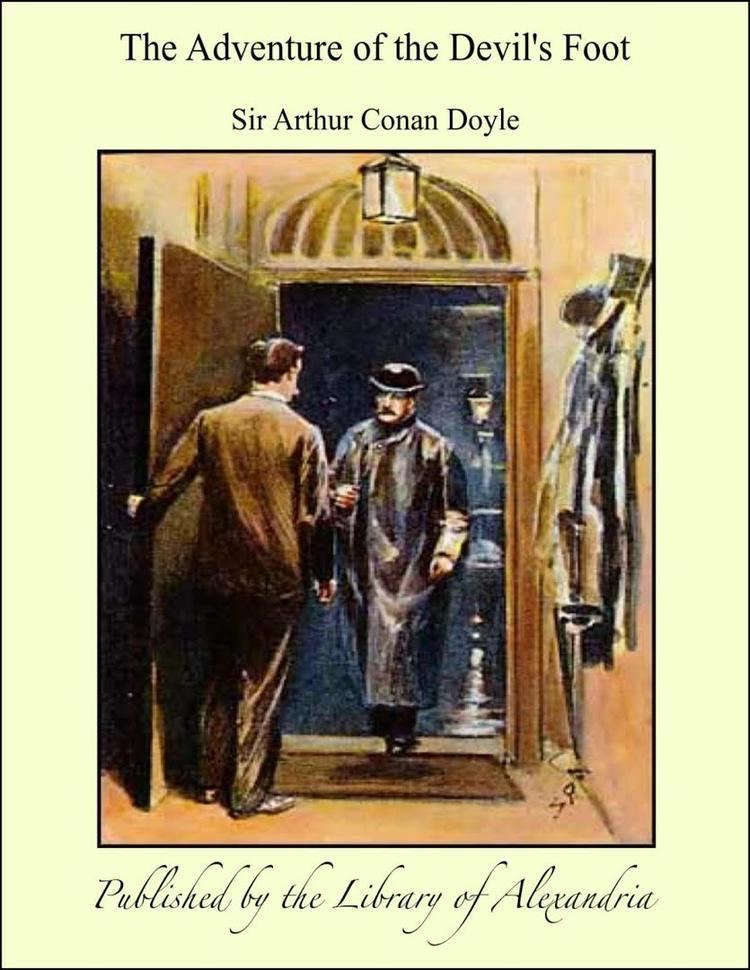8 /10 1 Votes8
Originally published 1910 Adaptations The Spider Woman (1944) | 4/5 Goodreads Publication date 1910 | |||||||||||||||||||||||||||||||||
 | ||||||||||||||||||||||||||||||||||
Similar Arthur Conan Doyle books, Other books | ||||||||||||||||||||||||||||||||||
"The Adventure of the Devil's Foot" is one of the 56 Sherlock Holmes short stories written by British author Arthur Conan Doyle. It is one of eight stories in the cycle collected as His Last Bow.
Contents
Doyle ranked "The Adventure of the Devil's Foot" ninth in his list of his twelve favorite Holmes stories.
Synopsis
Holmes and Dr. Watson find themselves at Poldhu in Cornwall one spring for the former’s health, but the holiday ends with a bizarre event. Mr. Mortimer Tregennis, a local gentleman, and Mr. Roundhay, the local vicar, come to Holmes to report that Tregennis’s two brothers have gone insane, and his sister has died. Tregennis had gone to visit them in their village (Tredannick Wollas), played whist with them, and then left. When he came back in the morning, he found them still sitting in their places at the table, the brothers, George and Owen, laughing and singing, and the sister, Brenda, dead. The housekeeper had discovered them in this state, and fainted. The vicar has not been to see them yet. Tregennis says that he remembers one brother looking through the window, and then he himself turned to see some "movement" outside. He declares that the horrific event is the work of the devil. Mortimer Tregennis was once estranged from his siblings by the matter of dividing the proceeds from the sale of the family business, but he insists that all was forgiven, although he still lives apart from them. The doctor who was summoned, reckoned that she had been dead for six hours. He also collapsed into a chair for a while after arriving.
Holmes goes to the house in question and, apparently carelessly, kicks over a watering pot, soaking everyone’s feet. The housekeeper tells Holmes that she heard nothing in the night, and that the family had been particularly happy and prosperous lately. Holmes observes the remains of a fire in the fireplace. Tregennis explains that it was a cold, damp night.
The case
Afterwards, Holmes lays the case out to Watson thus:
None of this seems to make for an elementary case, but soon, new questions are raised.
Dr. Leon Sterndale, the famous hunter and explorer, aborts his sailing from Plymouth after the vicar wired him (as the Tregennises are Sterndale cousins) with the tragic news. He asks Holmes what his suspicions are, and is displeased when Holmes will not voice them. After Sterndale leaves, Holmes follows him discreetly.
The morning after Holmes comes back to his room, apparently none the wiser for following Sterndale, the vicar arrives in a panic with the news that Mortimer Tregennis has now died in the same way as his sister. The two men, along with Watson, rush to Mortimer’s room, and find it foul and stuffy, even though the window has been opened. A lamp is burning on the table beside the dead man. Holmes rushes about, examining many things. The upstairs window seems especially interesting. He also scrapes some ashes out of the lamp, and puts them in an envelope.
Solution
Holmes deduces how the victims died or went mad and why people present when the death rooms were first opened fainted or felt unwell in each case. He tests his hypothesis by buying a lamp like the one in Tregennis’s room, lighting it, and putting some of the collected "ashes" on the smoke guard. The smoke from this powder is so potent a poison that Holmes is immediately struck down. Watson is able to resist and drags Holmes out of the room just in time.
It is clear to Holmes that Mortimer Tregennis poisoned his siblings, but who killed Mortimer?
It is Dr. Sterndale, who left physical evidence at the vicarage clearly implicating himself. Holmes confronts Sterndale, who explains that he loved Brenda for years (but had been unable to marry her because of the current marriage laws which prevented him from divorcing his wife even though she abandoned him years ago) and killed Mortimer in revenge for the cruel murder.
The poison is called Radix pedis diaboli ("Devil’s-foot root" in Latin), Sterndale collected from Africa as a curiosity. The toxic contents of the plant root are vaporized by heat and diffuse into the local atmosphere. He once explained to Mortimer what it was and what it was capable of, who then stole some to murder his siblings by throwing it on the fire just before he left. Mortimer thought Sterndale would be at sea before news reached Plymouth, but Sterndale recognized the poison’s effects from the vicar’s description of the tragedy and deduced right away what had happened.
Holmes’s sympathies in this matter lie with Sterndale, and he tells him to go back to his work in Africa.
Adaptations and derivative works
"The Devil's Foot" was dramatised for BBC Radio 4 in 1994 by Bert Coules as part of his complete radio adaptation of the canon, starring Clive Merrison as Holmes and Michael Williams as Watson, and featuring Patrick Allen as Leon Sterndale, Geoffrey Beevers as Reverend Roundhay, and Sean Arnold as Mortimer Tregennis.
"The Devil's Foot" served as the basis for a 1921 short film starring Eille Norwood as Sherlock Holmes, an episode of the 1965 television series Sherlock Holmes starring Douglas Wilmer, and a 1988 episode of The Return of Sherlock Holmes starring Jeremy Brett. Also, the 1944 film The Spider Woman is based on several of Doyle's Holmes stories, among them "The Devil's Foot."
